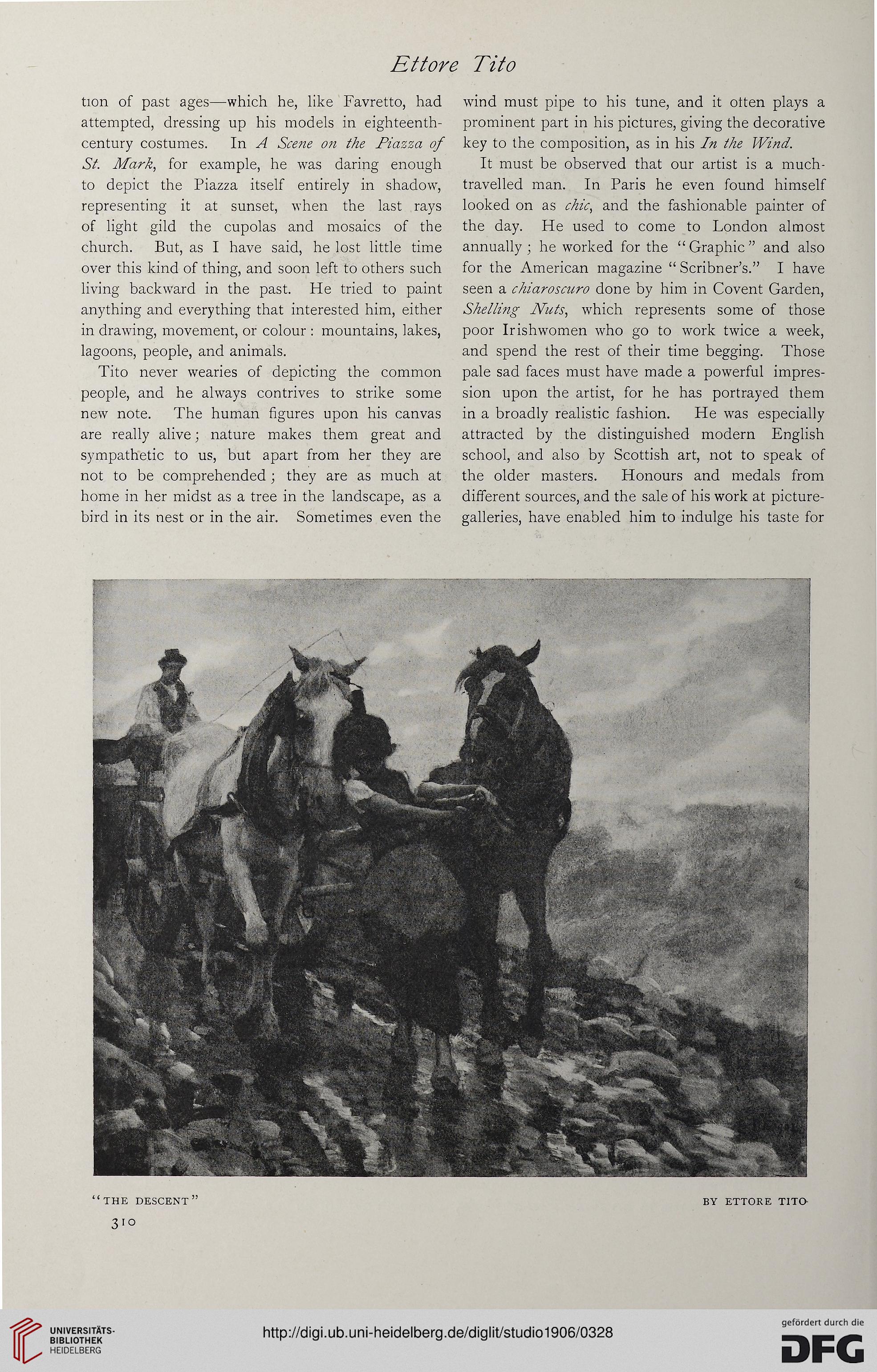Ettore Tito
tion of past ages—which he, like Favretto, had
attempted, dressing up his models in eighteenth-
century costumes. In A Scene on the Piazza of
St. Mark, for example, he was daring enough
to depict the Piazza itself entirely in shadow,
representing it at sunset, when the last rays
of light gild the cupolas and mosaics of the
church. But, as I have said, he lost little time
over this kind of thing, and soon left to others such
living backward in the past. He tried to paint
anything and everything that interested him, either
in drawing, movement, or colour : mountains, lakes,
lagoons, people, and animals.
Tito never wearies of depicting the common
people, and he always contrives to strike some
new note. The human figures upon his canvas
are really alive; nature makes them great and
sympathetic to us, but apart from her they are
not to be comprehended ; they are as much at
home in her midst as a tree in the landscape, as a
bird in its nest or in the air. Sometimes even the
wind must pipe to his tune, and it otten plays a
prominent part in his pictures, giving the decorative
key to the composition, as in his In the Wind.
It must be observed that our artist is a much-
travelled man. In Paris he even found himself
looked on as chic, and the fashionable painter of
the day. He used to come to London almost
annually; he worked for the “Graphic” and also
for the American magazine “ Scribner’s.” I have
seen a chiaroscuro done by him in Covent Garden,
Shelling JVuts, which represents some of those
poor Irishwomen who go to work twice a week,
and spend the rest of their time begging. Those
pale sad faces must have made a powerful impres-
sion upon the artist, for he has portrayed them
in a broadly realistic fashion. He was especially
attracted by the distinguished modern English
school, and also by Scottish art, not to speak of
the older masters. Honours and medals from
different sources, and the sale of his work at picture-
galleries, have enabled him to indulge his taste for
“the descent” by ettore titq
310
tion of past ages—which he, like Favretto, had
attempted, dressing up his models in eighteenth-
century costumes. In A Scene on the Piazza of
St. Mark, for example, he was daring enough
to depict the Piazza itself entirely in shadow,
representing it at sunset, when the last rays
of light gild the cupolas and mosaics of the
church. But, as I have said, he lost little time
over this kind of thing, and soon left to others such
living backward in the past. He tried to paint
anything and everything that interested him, either
in drawing, movement, or colour : mountains, lakes,
lagoons, people, and animals.
Tito never wearies of depicting the common
people, and he always contrives to strike some
new note. The human figures upon his canvas
are really alive; nature makes them great and
sympathetic to us, but apart from her they are
not to be comprehended ; they are as much at
home in her midst as a tree in the landscape, as a
bird in its nest or in the air. Sometimes even the
wind must pipe to his tune, and it otten plays a
prominent part in his pictures, giving the decorative
key to the composition, as in his In the Wind.
It must be observed that our artist is a much-
travelled man. In Paris he even found himself
looked on as chic, and the fashionable painter of
the day. He used to come to London almost
annually; he worked for the “Graphic” and also
for the American magazine “ Scribner’s.” I have
seen a chiaroscuro done by him in Covent Garden,
Shelling JVuts, which represents some of those
poor Irishwomen who go to work twice a week,
and spend the rest of their time begging. Those
pale sad faces must have made a powerful impres-
sion upon the artist, for he has portrayed them
in a broadly realistic fashion. He was especially
attracted by the distinguished modern English
school, and also by Scottish art, not to speak of
the older masters. Honours and medals from
different sources, and the sale of his work at picture-
galleries, have enabled him to indulge his taste for
“the descent” by ettore titq
310




